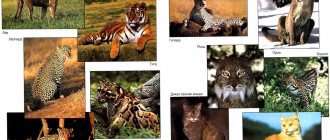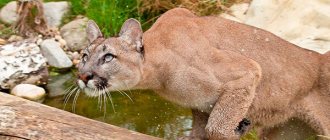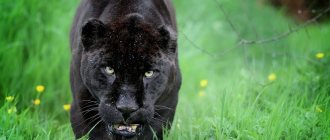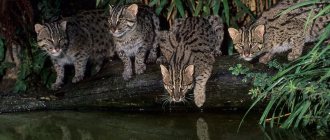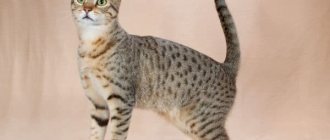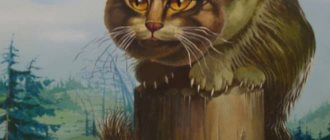Description
The length of the body of an adult is 1000-1300 mm, the length of the tail is about 800-1000 mm and is equal to approximately 75% to 90% of the total body length. This extremely long tail is used for balancing in the rocky and mountainous terrain where they live, and the animals also use it to keep their limbs warm during harsh winter weather. The average weight of an adult snow leopard is 35-45 kg. There is no pronounced sexual dimorphism among these animals, but males may slightly exceed females in weight. Compared to other felines, snow leopards have slightly larger front paws, with an average foot pad measuring 90 to 100 mm in length and 70 to 80 mm in width. They also have relatively long hind legs, adapted for better maneuvering and jumping in their habitat.
The fur color of the snow leopard varies from light gray to smoky gray, with a creamy yellow and white tint usually found on the belly. The entire body of the snow leopard is covered with gray-black spots, which are surrounded by black rings. Larger spots and rings surrounding them are found only on the body and tail, while solid spots are common on the head, neck and lower limbs. Juveniles have longitudinal black stripes running along the back from head to tail. As they grow and mature, these stripes break up into large spots that form lateral rows of elongated rings along the center of the back.
Snow leopards have long, thick fur that sheds twice a year. In winter it becomes thicker and longer. In summer, the length of the snow leopard's fur is about 25 mm on the sides and approximately 50 mm on the belly and tail. In winter, the fur reaches 50 mm on the sides, from 30 to 55 mm on the back, 60 mm on the tail and up to 120 mm on the belly. In addition to their thick fur, they have small, rounded ears that help minimize heat loss in cold conditions. Compared to other felines, snow leopards have much larger nasal cavities, as well as small and wide heads in relation to their body size.
How does the snow leopard hunt?
Snow leopards are famous predators. Moreover, they prefer to hunt even larger game than themselves, and most often do this from an ambush. Hiding on the rocks, the snow leopard alone patiently watches for potential prey near trails or watering holes. As soon as one appears within reach, the predator immediately rushes towards it and, after making several giant leaps, overtakes the prey. The snow leopard prefers to grab its prey by the throat. Most often, he immediately manages to strangle the animal or break its neck. The snow leopard first drags the already lifeless victim into shelter and only then begins to eat.
The leopard is the record holder for long jump among cats. In pursuit of prey, it can jump up to 6 m and 2.5-3 m in height. The long tail helps the animal maintain its balance.
Area
Snow leopards live over large areas of approximately 2.3 million square kilometers. They can be found on all the high mountain ranges of Central Asia. This includes the entire Himalayan mountain system, as well as areas in Bhutan, Nepal and Siberia of Russia. Snow leopards are found anywhere from the Himalayas to southern and western Mongolia and southern Russia, but 60% of the population is found in China, especially in the autonomous regions of Xinjiang and Tebet, and in the provinces of Sichuan, Qinghai and Gansu.
Habitat
Steep, rocky, and rugged terrain is the preferred resting place for snow leopards, particularly near natural vegetation. The cliffs and large ridges are ideal for daytime recreation. Snow leopards live in alpine and subalpine zones at altitudes from 900 to 5,500 meters and above, but most often at altitudes between 3,000 and 4,500 meters. In winter they can migrate to lower places, to an altitude of 900 meters. Snow leopards generally avoid dense forests and cultivated fields, but can inhabit coniferous forests, as well as arid and semi-arid scrubland, grasslands, mountain grasslands and barren areas.
In western Nepal, an area with high prey densities, the average habitat range size ranges from 12 to 39 square kilometers. However, in areas with difficult terrain, the actual range is likely to be 20-30% greater.
Keeping snow leopards in captivity
In 2008, there were approximately 600 Snow Leopards in zoos around the world. At the Richmond Metropolitan Zoo in Virginia, in the United States of America, snow leopard cubs were born in 2016.
Much progress has been made in ensuring the survival of the Snow Leopard and it has been successfully bred in captivity. Females usually give birth to two to three young per litter, but in some cases can produce up to seven.
Reproduction
Snow leopards are solitary animals and do not communicate with others of their own kind unless it is mating season. Due to the long time spent raising their young, females mate every second year. They are polygamous in the wild, but some snow leopards have been known to become monogamous in captivity.
Snow leopard breeding is highly seasonal and occurs from January to March. When females come into heat, they make a continuous squeaking sound that attracts males. The female offers herself to the male - she raises her tail and walks around him. During mating, the male grabs the hair on the female's neck, thereby holding her in one position. Gestation lasts 90-105 days, with cubs born from April to June. The number of offspring per litter is 2-3 kittens, but in rare cases varies from 1 to 5. They are born in rocky shelters, where the female makes a warm nest of wool on her belly. At birth, snow leopard kittens weigh between 300 and 600 grams.
Breastfeeding lasts about 5 months, but young animals can consume solid food as early as 2 months of age. The first year of life there is a close connection between the mother and her offspring. Females reach sexual maturity at 2-3 years, and males at 4 years.
Since snow leopards are solitary animals, the longest social contact occurs during the period when females are raising their offspring. Kittens are born blind and open their eyes when they reach one week of age.
The reproductive rate of snow leopards is higher in areas where females have the opportunity to hide in reliable shelter and also feed on prey nearby. This is necessary for the safety of their offspring, since inaccessible and reliable shelter helps hide the babies from other predators and allows females to hunt freely. After reaching three months of age, kittens follow their mother and learn basic survival skills such as hunting. During the first year of life, the mother provides the cubs with food, protection, training and other necessary resources.
Population and species status
Based on data from the World Wildlife Fund, between 3 and a half and 7 and a half thousand of these animals currently live on planet Earth. About a couple thousand more live and breed in zoos. The decline in the population of these predators is associated with illegal hunting for the valuable fur of the animal. Therefore, the snow leopard is considered a small, rare animal that is in danger of complete extinction.
Important fact! Despite the fact that all countries where the snow leopard is found protect these animals at the legal level and hunting them is prohibited, poachers still hunt them. Since 1997, the snow leopard has been listed in the Red Book of Mongolia under the status of “very rare”, and in some countries – under the status of “endangered as a species”.
The snow leopard is also listed in Appendix I of the Convention on International Trade in Endangered Species of Flora and Fauna. Under the same wording, the snow leopard was included in the 2000 IUCN Red List. As a result of the work of environmental structures that monitor the dynamics of poaching of animal fur, it was found that the provisions for the protection of the species in almost all countries, although being implemented, are insufficient. In addition, none of the countries have adopted long-term programs that would allow the conservation of the snow leopard.
Snow leopard prince of the mountains Wildlife animals of the taiga of the Far East Red Book of rare species
Behavior
Snow leopards are most active during dawn and dusk. They are also very mobile and can move from one place to another every day and change their resting place several times during the day. Generally, they stay in one specific area for several weeks and then move to another.
Snow leopards are solitary animals, but during the mating season they are in pairs, so they share territory with each other. Individuals that are forced to share territory maintain a distance of approximately 2 km from the nearest individual. Snow leopards avoid each other by marking their paths with scratches, feces and special glands that can describe the sex and reproductive status of the individual.
They have a well-developed ability to jump high thanks to their wide paws and elongated hind legs. Snow leopards prefer to spend their time on tall structures, especially when living in captivity. A rare observation of the behavior of snow leopards in captivity has determined that the animals reduce their activity in places where people are present.
The preferred method of hunting is stalking. They then ambush their prey from higher ground, using rocky terrain and shrubby vegetation for camouflage.
Communication and perception
Unlike other large cats, snow leopards do not growl. Instead, they emit a high-pitched howl, especially females during the breeding season. This sound allows females to notify males of their location and, as a rule, this happens late in the evening. Vocalizations are non-aggressive and the sound is produced through the nostrils of the animals. The presence of one snow leopard in close proximity to another produces this sound, and can be described as a greeting.
Snow leopards make high-pitched sounds and communicate their location. Their long tails are used in a number of communication functions. Animals also use tactile communication, namely rubbing the head and neck of their social partner, which indicates a peaceful mood.
Another way of communication is facial expressions. For example, when defending, they open their jaws quite wide and lift their lips to expose their fangs. However, when they are friendly, they only open their mouth without exposing their fangs, and also wrinkle their nose.
Snow leopards, like other felines, prefer to communicate through scents and other chemicals.
A little history of the species
Although these animals were originally thought to be the first species to diverge within the genus Panthera, they have recently been shown to form a sister clade to tigers. Some scientists believe that it is likely that these two groups separated from the rest of the Panthers between 4.6 and 1.8 million years ago, and then split among themselves about 3 million years ago. Given the fact that tigers have the same ability to roar as the rest of the genus Panthera, but snow leopards do not, it is possible that this feature was present in the common ancestor of Panthera, which has disappeared in snow leopards since they split from tigers.
Nutrition
Snow leopards are carnivores and actively hunt for their prey. They are also opportunistic predators and will consume any meat to provide their body with the energy it needs. Snow leopards are capable of killing animals 3-4 times their weight, but if necessary they can consume much smaller prey.
The main animal that snow leopards feed on is nakhur (Pseudois nayaur). Other prey species include Siberian ibex (Capra ibex sibrica), marking goat (Capra failconeri), argali (Ovis ammon), mouflon (Ovis orientalis), Himalayan tahr (Hemitragus jemlahicus), Sumatran serow (Capricornis sumatraensis), Himalayan goral (Naemorhaedus goral), red-bellied musk deer (Moschus chrysogaster), wild boar (Sus scrofa), orongo (Pantholops hodgsonf), Tibetan gazelle (Procapra picticaudata), goitered gazelle (Gazella subgutturosa) and wild ass (Equus hemionus). Small prey includes marmots (Marmota), hares (Lepus), pikas (Ochotona), gray voles (Microtus), mice and birds.
Due to overhunting by humans, the population of wild ungulates in certain regions has declined significantly, and snow leopards have begun to prey on livestock.
Threats
Snow leopards are predatory animals, so they have fewer threats from wild animals than from people. However, interspecific killing between leopards (Panthera pardus) and snow leopards can occur when competition for resources increases. Adults are also a potential threat to young animals.
In the last two decades, the population has declined by at least 20% due to habitat loss, prey, poaching and persecution. The main factor influencing population decline is human activity. Wool, bones and other body parts are of particular value to poachers. The skin is in great demand. Recently, their bones have become a popular substitute for tiger bones in Chinese medicine. Many farmers are responsible for killing snow leopards and risk losing their livestock.
How much does a Snow Leopard cost?
The main threat to Snow Leopard populations is poaching and the illegal trade in pelts and body parts. In China, from 103 to 236 animals are killed annually by poachers, in Mongolia from 34 to 53, in Pakistan from 23 to 53, in India from 21 to 45 and in Tajikistan from 20 to 25. Poaching is associated with a reduction in production and the destruction of livestock.
Greenhouse gas emissions will likely cause the predator's range in the Himalayas to shift and the alpine zone to shrink, which could reduce the snow leopard's range by 30%.
Numerous agencies work to conserve the unique predator and its mountain ecosystems. These include the Snow Leopard Trust, Snow Leopard Conservancy and other programs.
It is impossible to legally purchase an Irbis kitten. The cost of a predator acquired illegally from smugglers reaches exorbitant amounts. But since this animal is a rare and endangered species, such a purchase is strictly punished.
Role in the ecosystem
Snow leopards are apex predators, meaning they play a key role in maintaining biodiversity in the ecosystem. They are an important indicator of environmental health and help regulate animal populations lower on the food chain.
Snow leopards can be recognized as indicator species, and this is important because it provides an opportunity to motivate the public to support ecosystem conservation. If snow leopard habitats are protected, many other animals will also have their habitats protected.
Parasites that live off the snow leopard: heartworms, toxoplasma, roundworm, fleas, ticks, strongylids, nematodes, etc.
Population revival
In recent years, joint efforts by international organizations and governments to save snow leopards have begun. Protected areas have already been created throughout the habitat of big snow cats, including nature reserves in Afghanistan, Mongolia and Kyrgyzstan. The reserve in Kyrgyzstan played a special role in this process, as the country's mountain ranges served as a corridor for snow leopards moving between the northern and southern parts of their range.
Snow leopard home countries are also stepping up anti-poaching efforts, and conservation groups are working with herders to create systems to separate and keep snow leopards away from livestock.
People's awareness of the importance of the role of leopards for the environment is also gradually increasing. As a flagship species, this beautiful animal is a kind of talisman for the entire ecosystem: if they survive and revive their population, then many other species of animals in their habitat will also survive.
